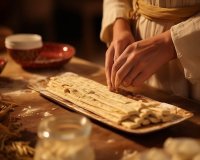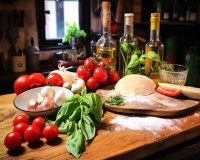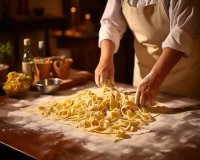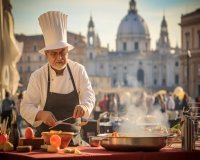Essential Tips for Cooking Handmade Pasta Like a Pro
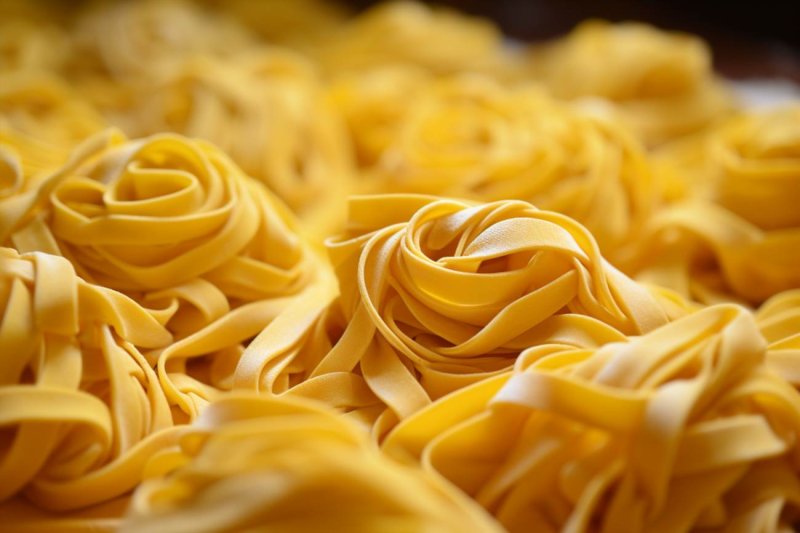
Essential Tips for Cooking Handmade Pasta Like a Pro
If you've ever visited Rome, you know that one of the city's culinary delights is its handmade pasta. Whether it's the simplicity of Cacio e Pepe or the richness of Carbonara, Roman pasta dishes are beloved around the world. To replicate these flavors at home, here are some essential tips for cooking handmade pasta like a pro.
Choose the Right Pasta
The first step in crafting a fantastic pasta dish is selecting the right pasta. In Rome, you'll often find dishes made with long, thin pasta like spaghetti or fettuccine. These shapes work well with creamy sauces and are a great choice for classic Roman recipes. However, you can experiment with different shapes to suit your taste.
Use High-Quality Ingredients
Roman cuisine emphasizes the use of high-quality, fresh ingredients. When making handmade pasta, ensure you use the best-quality eggs and flour available. The combination of these two simple components is the foundation of an excellent pasta dough. Look for organic or free-range eggs for the best flavor.
Master the Dough
Creating the perfect pasta dough is an art in itself. To make the dough, combine flour and eggs in a bowl, and knead until you achieve a smooth, elastic texture. It's essential to let the dough rest for about 30 minutes to relax the gluten, making it easier to roll out and shape.
Roll It Out Thin
One characteristic of Roman handmade pasta is its thinness. To achieve this, invest in a good-quality pasta machine or use a rolling pin. Roll the dough out gradually, ensuring it's thin enough to see your hand through. This thinness allows the pasta to cook quickly and absorb the sauce effectively.
Cut with Precision
After rolling the dough to perfection, the next step is cutting it into your desired shape. While traditional Roman pasta is often cut into ribbons or fettuccine, you can experiment with different shapes. Just remember that consistency in size is key to even cooking.
Cook Al Dente
When it comes to cooking handmade pasta, the phrase "al dente" should be your mantra. It means the pasta should be cooked to be firm to the bite. To achieve this, follow the instructions on your pasta's packaging and taste-test a piece a minute or two before the recommended time. It should have a slight firmness when bitten.
Save Some Pasta Water
Before draining your pasta, remember to save a cup of the cooking water. This starchy liquid can be a lifesaver when it comes to creating a creamy sauce. It helps bind the pasta and sauce together, giving your dish that perfect consistency.
Pair with the Right Sauce
In Rome, each pasta shape has a traditional sauce that complements it perfectly. For example, spaghetti often pairs with tomato-based sauces, while fettuccine suits creamy sauces like Alfredo. Do some research and find the ideal sauce to match your chosen pasta shape for an authentic Roman experience.
Don't Overdo the Cheese
When it comes to garnishing your Roman pasta dish, less is often more. While cheese is a beloved ingredient, it should be used sparingly. For Cacio e Pepe, for instance, use Pecorino Romano cheese, but use it in moderation. The cheese should enhance the flavors rather than overwhelm them.
Practice and Patience
Finally, remember that cooking handmade pasta like a pro takes practice and patience. Rome wasn't built in a day, and neither is perfecting your pasta-making skills. Embrace the journey, experiment with different recipes, and savor the delicious results along the way.
By following these essential tips, you can recreate the flavors of Rome in your own kitchen and cook handmade pasta like a true pro. Buon appetito!
Rome: Pasta Cooking Experience in Mamma's Kitchen
Discover the art of crafting homemade pasta in the heart of Rome with this immersive cooking class. Led by a local chef, embark on a journey to a bustling market to handpick fresh ingredients, setting the stage for an authentic culinary experience.
Once armed with your chosen ingredients, step into Mamma's kitchen and delve into the secrets of crafting pasta like a true Italian. Receive hands-on guidance from your chef teacher, offering valuable insights into the art of pasta making.
Take a break from the usual sightseeing and indulge in the delightful aromas of your culinary creations. Following the cooking session, relish a leisurely lunch paired with a glass of local wine, fostering a sense of camaraderie among fellow amateur chefs.
Depart with not just a satisfied appetite but also newfound skills and recipes to impress your loved ones back home.
What to Expect
- Visit a local market for fresh ingredients
- Hands-on experience in crafting homemade pasta
- Insights and tips from a skilled local chef
- Leisurely lunch with fellow participants
- Complimentary glass of local wine
Meeting Point
Via Palestro 51, 00185 Rome. Please arrive at least 10 minutes before the activity starts.
Experience the culinary traditions of Rome in a memorable pasta-making adventure, combining education, delicious flavors, and the warmth of Mamma's kitchen.
Choosing the Right Ingredients in Rome
Rome, the eternal city, is renowned for its rich culinary heritage. From classic pasta dishes like carbonara and cacio e pepe to the mouthwatering pizzas and gelato, the flavors of Rome are a gastronomic delight. But what truly sets apart a memorable Roman meal from an ordinary one is the art of choosing the right ingredients. In this article, we will explore the importance of selecting quality ingredients when preparing Roman cuisine.
The Foundation of Roman Cuisine
Roman cuisine is all about simplicity and celebrating the natural flavors of fresh ingredients. With its roots in Cucina povera, a humble and rustic cooking tradition, Roman dishes are a testament to the skill of transforming a handful of simple ingredients into something extraordinary.
When it comes to Roman cooking, there are a few key ingredients that hold a special place:
| 1. Pasta |
Rome is synonymous with pasta, and choosing the right pasta is crucial. Opt for high-quality durum wheat pasta, as it holds sauces better and offers a delightful texture. |
| 2. Olive Oil |
The heart of many Roman dishes, olive oil should be extra-virgin and cold-pressed to enhance the dishes' flavors. |
| 3. Pecorino Romano Cheese |
This salty sheep's milk cheese is a staple in Roman cuisine. Use it for authentic carbonara, amatriciana, and cacio e pepe. |
| 4. Fresh Produce |
Roman dishes are characterized by their use of fresh and seasonal vegetables like artichokes, zucchini flowers, and tomatoes. |
| 5. Guanciale |
This cured pork jowl adds a unique depth of flavor to pasta dishes like carbonara. Use a high-quality variety for the best results. |
The Pasta Paradigm
Pasta is the cornerstone of Roman cuisine. It's essential to choose the right pasta shape to match your sauce. For carbonara and cacio e pepe, select long pasta like spaghetti or bucatini. Short pasta like rigatoni or penne is perfect for sauces like all'amatriciana. Ensure that the pasta is cooked al dente to retain its firmness and texture.
The Secret of Authenticity: Pecorino Romano
Pecorino Romano cheese is a vital ingredient in many Roman dishes. It's a sharp, salty cheese that elevates the flavors of pasta dishes to new heights. When selecting Pecorino Romano, look for the DOP (Denominazione d'Origine Protetta) label, which guarantees authenticity and quality.
The Allure of Fresh Produce
Roman cuisine is deeply rooted in the use of fresh, seasonal produce. The vibrant colors and flavors of vegetables like artichokes, zucchini flowers, and tomatoes are integral to dishes like carciofi alla romana (Roman artichokes) and Fiori di Zucca (zucchini flowers).
The Irreplaceable Guanciale
Guanciale is a type of Italian cured meat made from pork jowl or cheeks. It plays a starring role in many Roman pasta dishes. When choosing guanciale, ensure it's from a reputable source and has the right balance of fat and meat. This ingredient infuses dishes with a rich, savory flavor that's hard to replicate with any other meat.
Conclusion
In Rome, the heart of Italian cuisine, selecting the right ingredients is the key to creating an authentic and unforgettable dining experience. Whether it's pasta, olive oil, cheese, fresh produce, or guanciale, each ingredient contributes to the rich tapestry of flavors that make Roman dishes a true delight. By embracing the art of ingredient selection, you can embark on a culinary journey through the streets of Rome, savoring the essence of this historic city with every bite.
Rome Pasta-Making Cooking Class at Piazza Navona
Indulge in the art of Italian pasta-making with a delightful cooking class held at Rome's charming Piazza Navona. Experience the culinary secrets of crafting homemade Fettuccine pasta under the expert guidance of local Italian chefs. Immerse yourself in the authentic Italian ambiance and forge new connections while savoring complimentary bruschetta and beverages.
About the Experience
Delve into the heart of Italian culinary tradition by learning to make the perfect Italian pasta. In this engaging workshop, our skilled chefs will not only teach you the art of pasta-making but also offer a glimpse into the Italian way of life. Savor the prepared Fettuccine pasta, meticulously cooked and paired with a sauce of your choice.
Enhance your pasta-making experience with appetizers such as bruschettas and included beverages, all within the captivating setting of our restaurant overlooking Piazza Navona and its Renaissance fountains. Connect with fellow travelers and groups, immersing yourself in the city's vibrant culture through the lens of Italian cuisine.
Additional Information
Please note: This class does not offer a gluten-free option.
Includes
Our cooking classes take place at the historic Ristorante Tucci, nestled within the iconic Piazza Navona. Led by our enthusiastic local chefs, the class focuses on crafting handmade Fettuccine pasta, allowing participants to choose their preferred sauce. Guests can enjoy a glass of wine, beer, or soda and bruschetta as an appetizer, followed by the delightful pasta meal served with a stunning view of Piazza Navona.
Meeting Point
We welcome our guests at Ristorante Tucci. Upon arrival, kindly seek assistance from the restaurant staff to direct you to the cooking class. Please arrive on time, as the class cannot wait beyond 10 minutes for late arrivals.
Secrets of Rolling the Dough in Rome
Rolling dough is an art, and in Rome, it's elevated to a tradition that spans generations. The secrets of rolling the perfect dough are closely guarded, passed down from Nonna to granddaughter, whispered in bustling kitchens and busy pizzerias.
Understanding the Basics:
Before delving into the secrets, it's crucial to understand the basics of dough rolling. A good dough is a foundation for any delicious pizza or pasta dish. It starts with high-quality flour, water, salt, and yeast, mixed and kneaded to perfection.
The Roman Touch:
Rome is renowned for its thin-crust pizzas, and the secret lies in the rolling. Romans have mastered the art of stretching and thinning the dough without compromising its integrity. The thin crust allows the flavors of the toppings to shine while providing a delightful crunch.
Secret 1: The Right Flour
The type of flour used plays a pivotal role in dough rolling. Romans often opt for a high-protein flour, which results in a chewy yet delicate texture. The combination of flour, water, and other ingredients contributes to the distinctive Roman pizza crust.
Secret 2: Patience is a Virtue
Rome wasn't built in a day, and neither is the perfect pizza dough. Patience is a key secret. Allowing the dough to rise slowly and naturally enhances its flavor and texture. Romans understand that good things come to those who wait, especially when it comes to culinary masterpieces.
Secret 3: Technique Matters
Rolling dough is not just about force; it's a delicate dance between hands and dough. The technique involves gentle stretching, ensuring an even thickness across the entire surface. Romans often use a rolling pin sparingly, relying on the finesse of their hands to achieve the desired thinness.
Secret 4: Temperature Control
Temperature control is a secret weapon in Roman kitchens. The ambient temperature affects the fermentation process and the elasticity of the dough. Romans pay careful attention to room temperature, proving that precision is key to a perfect pizza crust.
Secret 5: Tradition and Passion
Perhaps the most crucial secret is the infusion of tradition and passion into the process. Romans approach dough rolling with a deep-seated love for their culinary heritage. The connection to family traditions and the joy of sharing a meal with loved ones imbues the dough with an intangible, but undeniable, flavor.
Conclusion:
In the heart of Rome, the secrets of rolling the dough are not just culinary techniques; they are a testament to a rich cultural legacy. The next time you savor a slice of Roman pizza, remember that it's not just about the toppings—it's about the artistry of rolling the dough, a skill that has been perfected through generations.



